5 Moves to Strong Pecs: The Essential Chest Guide
The pectoral muscles— aka your chest muscles help you push objects away from you and are the primary movers behind several key strength-testing exercises you do in the gym or in your everyday life.
One of the key components of a Greek God workout that will leave you sculpted, toned and defined like a Classical statue is harnessing the best exercises to develop strong pecs.
This article will give you a rundown on what your pec muscles are and how to build strong pecs as part of a functional and aesthetic workout. We’ll give your five key moves with simple how-to instructions that you can add to your chest day workout routine.
What are the Pecs?
Though we’re used to referring to only your largest chest muscle— the pectoralis major— as “pecs,” there are several powerful muscles at work that make up your chest.
Pectoralis Major
Location: The pectoralis major is the larger and more superficial of the two pectoral muscles. It covers much of the upper chest.
Structure: It is a thick, fan-shaped muscle that extends from the clavicle (collarbone), sternum (breastbone), and the cartilage of the first six ribs, converging to attach to the humerus (upper arm bone).
Functions: This muscle has a few significant functions. It helps you bring your arms toward your body's midline (adduction), raise your arms forward (flexion), rotate your arms inward (internal rotation) and move your arms across the chest like you would to hug someone (horizontal adduction).
Pectoralis Minor
Location: The pectoralis minor lies beneath the pectoralis major and is smaller in size.
Structure: It originates from the third, fourth, and fifth ribs and inserts into the coracoid process of the scapula (shoulder blade).
Functions: Your pectoralis minor helps stabilize the scapula (your shoulder blades). It can help you lower the shoulder blades down (depression), or move them forward and around the rib cage (shoulder blades protraction). You do this in most pushing movements.
Benefits of Strong Pecs
What are the key benefits of improving your pectoral muscle strength? It’s not just part of an aesthetic workout to build up your chest. This major strength center has plenty of functional benefits too.
Upper Body Strength
Strong pecs are essential for helping you push. Any pushing movements, like push-ups, bench presses, and dips, take strength from your pectorals. This applies to your everyday life, too. Simple things like pushing a heavy door open would require the strength of your chest.
Posture
Building strong pecs also contributes to better posture. If you want to stand a little straighter, the front and back of your body need balanced levels of strength so you don’t hunch over or develop sloped shoulders. By balancing the strength of the upper back muscles.
Breathing
Your pectoralis minor helps you with deep breathing by lifting your ribs as you inhale.
Common Exercises for Pectoral Muscles
- Bench Press: Targets the pectoralis major, especially the sternal head.
- Push-Ups: Engages both the pectoralis major and minor.
- Chest Flyes: Focuses on the pectoralis major.
- Cable Crossovers: Works the entire chest, with emphasis on the pectoralis major.
- Dips: Primarily targets the lower part of the pectoralis major and the triceps.
Maintaining strong and balanced pectoral muscles is essential for overall upper body strength, functional movement, and posture
Top 5 Exercises for Strong Pecs
Here are the exercises that can help you build strong pecs:
1. Bench Press
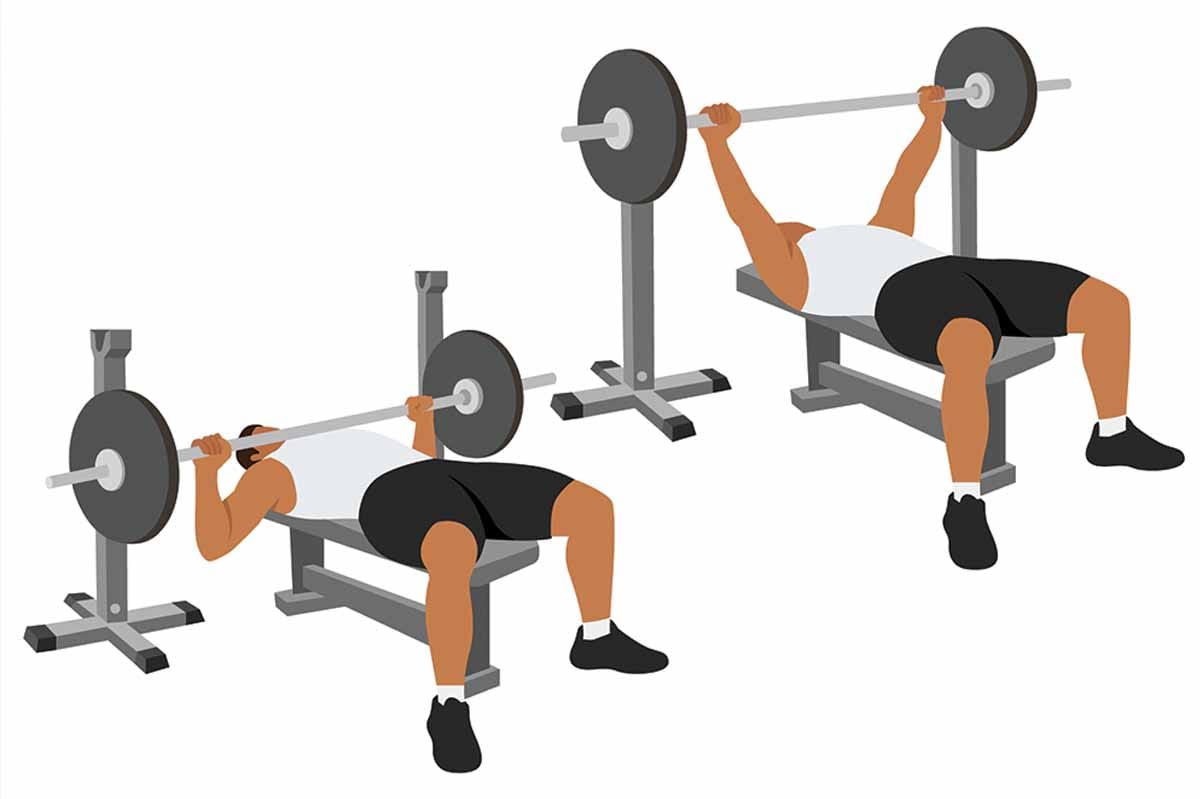
- Set-Up: Lie on a flat bench with a dumbbell in each hand. Your weight should feel comfortable but challenging. Face your palms forward.
- Lift: Press your dumbbells straight into the air until your arms are fully extended.
- Reverse: Hold for a pause, then lower your weights back down until your elbows come to a 90-degree angle. Keep your back flat and core engaged as you lift.
- Reps: Try for 3 sets of 10-12 reps.
2. Push-Ups
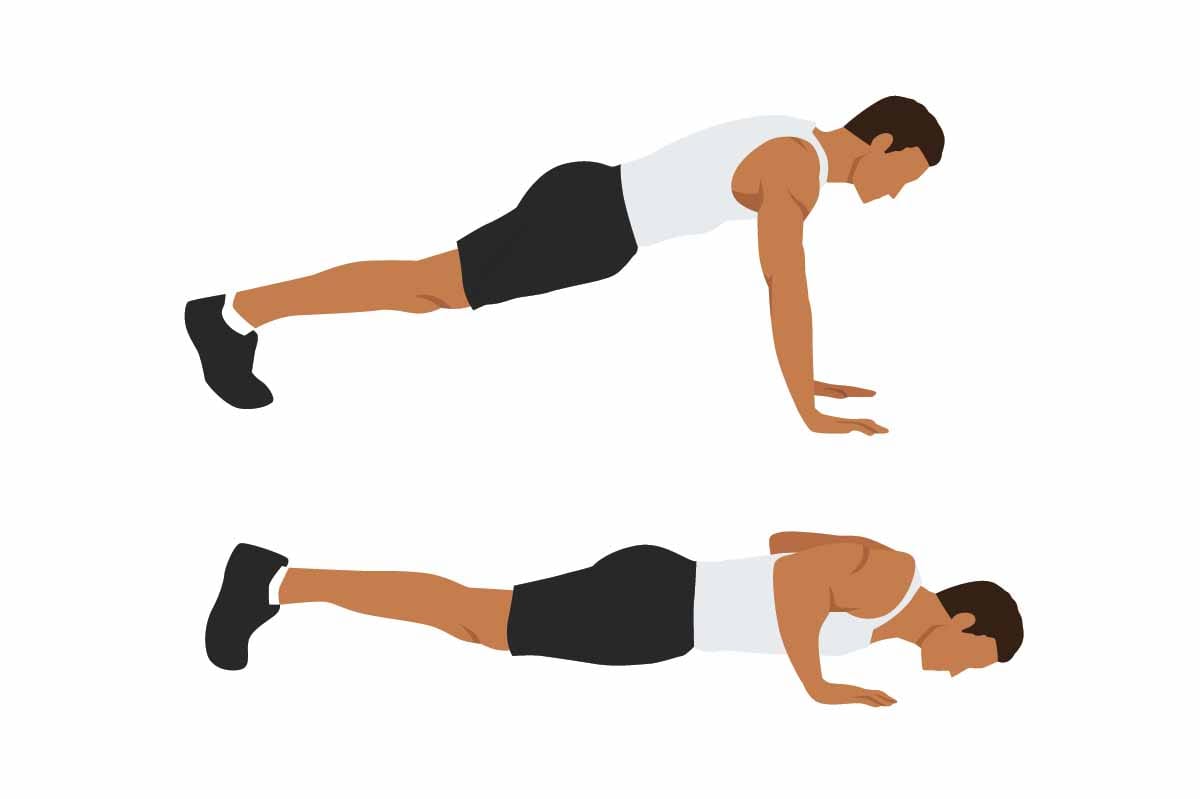
- Set-Up: Begin in a plank position with your hands slightly wider than shoulder-width apart. Your body should form a straight line from head to heels, with fully extended arms.
- Action: From here, bend your elbows and lower your body toward the ground. Keep your elbows pointing backwards as you do this to prevent shoulder injuries. Hold your body straight. Don’t let your hips sag below the rest of your body or stick your butt up in the air. Doing either takes away from your core engagement. Lower yourself until your chest is just above the ground with your elbows reaching 90 degrees.
- Reverse: Push through the palms of your hands to straighten your arms and bring your body back to the starting position using your strength. Keep your body straight throughout the movement.
- Reps: 3-4 sets of 10-12 reps.
3. Chest Fly
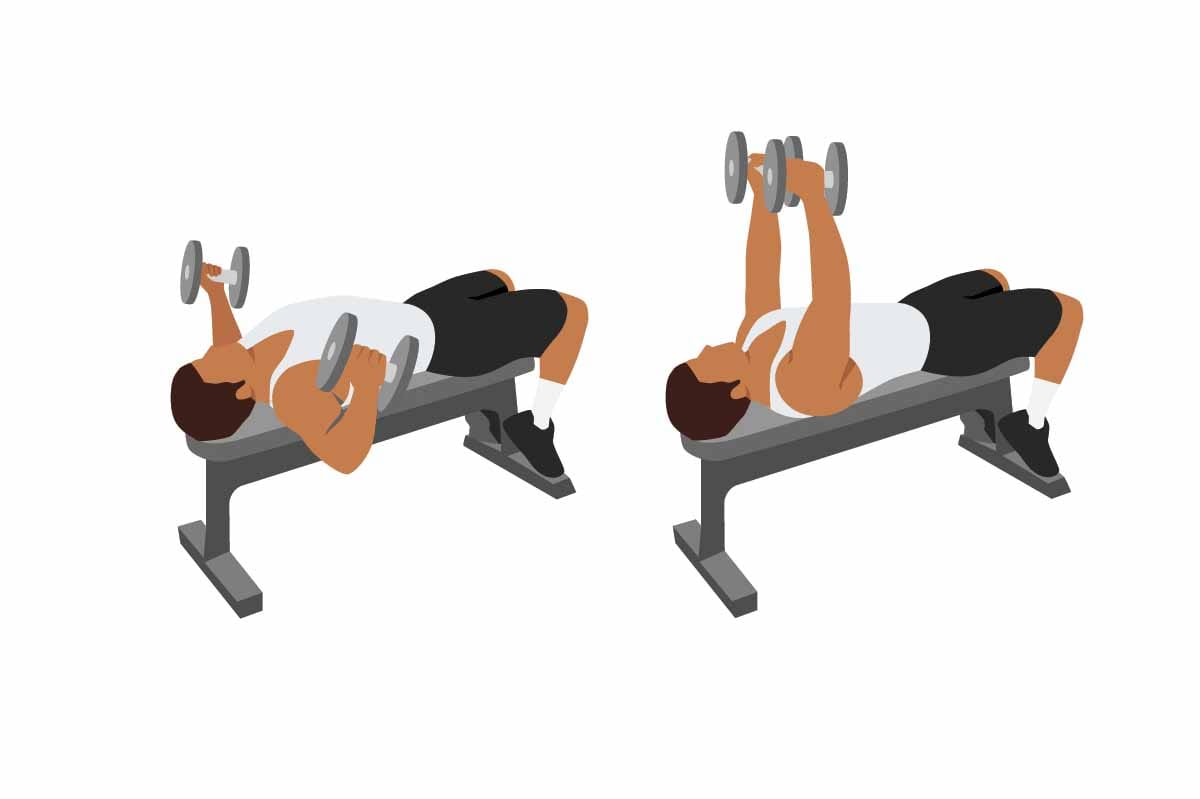
- Set-Up: Lie on a flat weight bench with a dumbbell in each hand. Face your palms inward, so they’re turned towards each other.
- Lift: Extend your arms straight up over your chest, slightly bending your elbows. This will be your starting position.
- Reverse: Lower the dumbbells out to the sides, making an arc shape, until you feel your chest stretching and engaging. At this point, bring your arms back together over your chest with control.
- Reps: 3 sets of 10-12 reps.
4. Cable Crossover
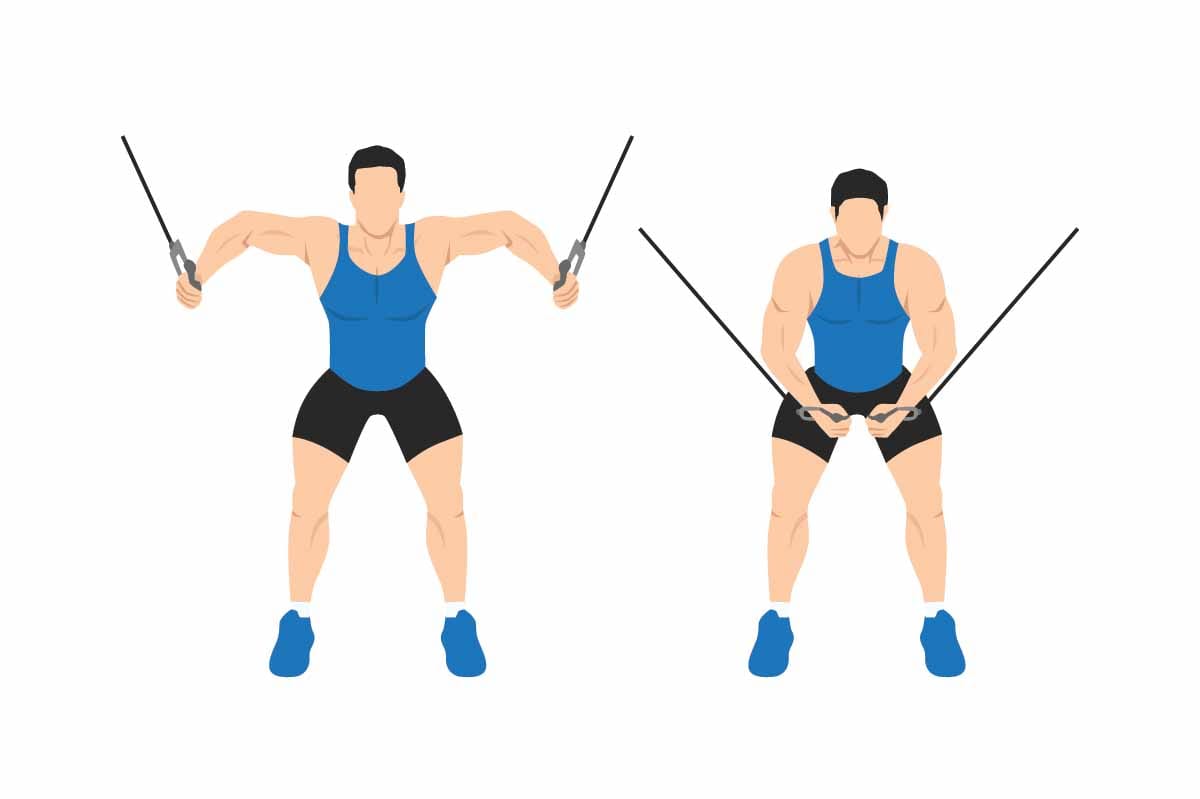
- Set-Up: Position the pulleys to a high position on the cable machine. Select an appropriate weight on both sides. Stand between the pulleys and grasp the handles with each hand.
- Body Position: Stand with feet shoulder-width apart, one foot slightly in front of the other for stability. Keep your back straight, chest up, and core engaged. Extend your arms out to the sides with a slight bend in the elbows.
- Action: Slowly bring the handles down and forward in a wide arc, crossing your hands in front of your body at chest height. Squeeze your chest muscles together.
- Reverse: Slowly and controlled, reverse the motion, bringing your arms back to the starting position.
- Reps: 4 sets of 10-12 medium-weight reps.
5. Dips
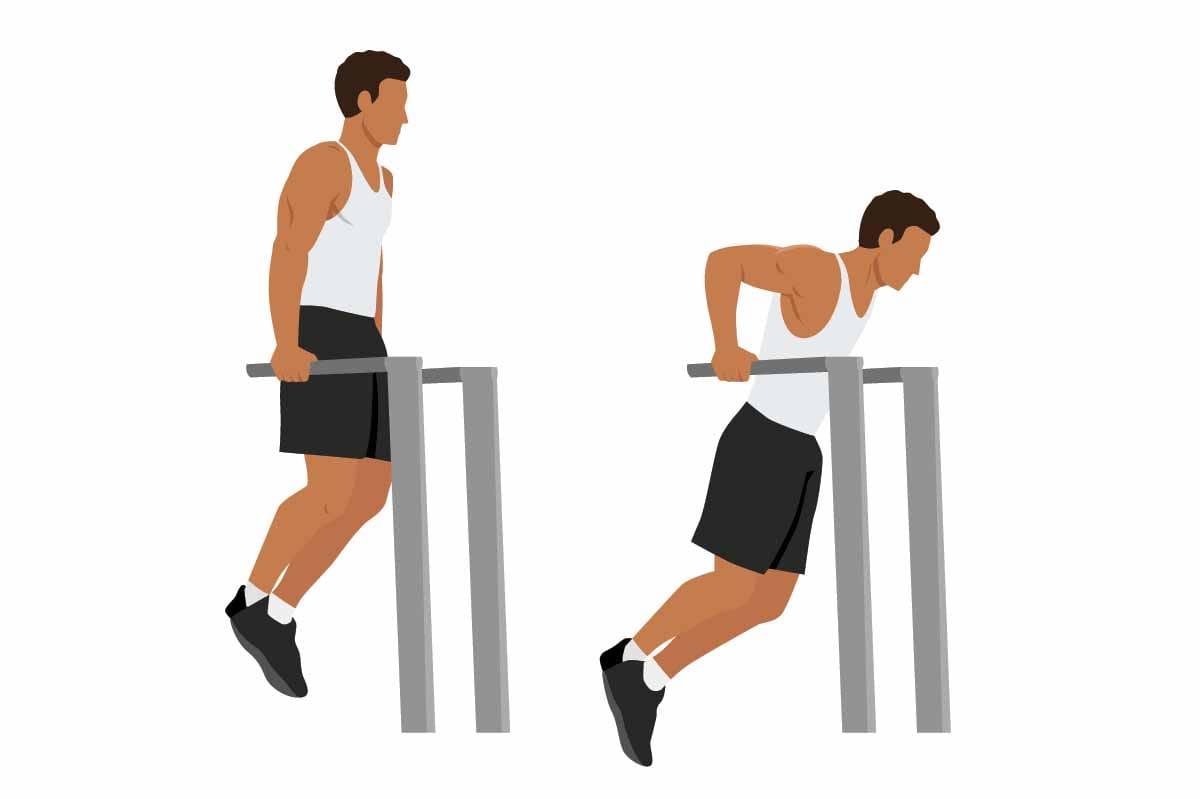
- Set-Up: Attach a weight belt around your waist with the desired weight. You can also use plates chained to your belt, dumbbells, or a weight vest. Secure your weight so it hangs down between your legs or is evenly distributed across your torso.
- Body Position: Grab the parallel bars of a dip station, keeping your palms facing in towards each other and your arms fully extended. Keep your body upright and chest proud. You can cross or bend your legs at the knees for stability.
- Action: With control, slowly lower your body by bending your elbows, keeping them tucked into your sides. Lean slightly forward to engage your chest muscles more. Continue lowering until your upper arms are parallel to the ground or you feel a stretch in your chest and shoulders.
- Reverse: Push yourself back up to the starting position by straightening your arms. Keep your core engaged and maintain a controlled movement throughout.
- Reps: 3-4 sets of 8-12 reps. Weighted dips’ benefits are also numerous. For an added challenge, try this variation if you’re at an advanced level.
Why Won’t My Pecs Grow?
There can be several reasons why your pectoral muscles (pecs) aren't growing despite your efforts. Here are some common factors to consider:
Not Enough Muscle Stimulation
Too Little Progressive Overload: To build muscle, you need to gradually increase your weight, reps, intensity or some combination of all three. If your workouts are too easy, too short, or you’re not pushing yourself, your muscles won’t grow.
Lack of Volume: To grow muscles, you need to get in enough sets and reps per week. This promotes what’s called muscular hypertrophy or the growth of muscle fibers and tissues. To grow strong pecs, make sure you’re working out at a high enough volume.
Bad Form: Using improper form can hinder you from full muscular engagement in your pectorals. This makes your workouts less effective and can be a major time waster if your technique is totally botched.
Poor Nutrition
Caloric Deficit: If you want to build muscle, you need to eat at a calorie surplus. That means taking in more calories than you’re burning. If you’re not eating enough calories, your body won’t have the energy it needs to grow muscle.
Lack of Protein: Protein is mandatory to help you repair and grow your muscle tissues. Make sure you’re consuming enough high-quality protein from different sources. Good lean proteins you can add to your diet include:
Overall Poor Diet: Make sure you balance out the extra protein with enough carbs and fats to support your muscle growth. Although we can consider protein the main “building block” for your muscles, carbs and healthy fats are just as important.
Carbohydrates are where you derive most of your energy for workouts. If you notice you’re frequently lethargic and feel too lazy to workout, you’re likely not eating enough carbs. Keep track of your overall energy levels. You may want to keep a workout journal where you record how you feel during exercise. A workout app like Flex can be an even better option since it’s easier to reference prior workouts to spot patterns and trends in your training.
Recovery
Too Little Rest: Muscles grow during rest periods, not during workouts. Ensure you’re giving your pecs enough time to recover between sessions.
Sleep Deprivation: Lack of sleep can hinder muscle recovery and growth. Aim for 7-9 hours of quality sleep per night. For more information on how training and supplementation can impact your sleep. Read Can I Take Creatine Before Bed.
Overtraining: Too much exercise can do more harm than good. It’s often the cause of things like sore quads, lower back pain when squatting, and— when applied to the upper body— can absolutely cause your pecs to hurt, too. Overtraining doesn’t lead to stronger pecs, and, in fact, can stall muscle growth.
Make sure you’re taking at least a day between training sessions for this muscle group. If you follow a plan like a bro split workout or any kind of three-day split, you may even take multiple days between chest training sessions.
Genetic Factors
Genetic Limitations: Some people may simply have bad chest genetics, which don’t allow them to gain as much size as pecs. Genes and weightlifting performance are strongly linked with genes like ACTN3 being known as the “speed gene” which encodes for fast-twitch muscle fibers.
Ultimately a combination of genes can influence your ability to build muscle. Some people may have a harder time building certain muscle groups due to their genetic makeup.
Hormonal Issues
Hormonal Imbalances: Hormonal issues, like low testosterone, can affect your ability to grow muscle. If you suspect hormonal problems are behind your small pecs, consider speaking with your doctor or a healthcare professional.
If you address these factors, you’ll have a more realistic and informed outlook to growing your pecs. It’s often a combination of several elements that can give you better results.
Big Picture
Growing strong pecs stems from a combination of factors, but is achievable to some extent by people who are dedicated to training and eating right.
We recommend using medium-weight to heavy staple exercises as the base behind building your pecs.
These are some key focus moves you can use to build strong pecs:
- Bench Press
- Push-Ups
- Chest Flye
- Cable Crossover
- Dips
Reference our how-to guides above in this article if you need a refresher on form and you’re all set to go when building your pectoral muscles up in the gym.
References
Carbone, J. W., & Pasiakos, S. M. (2019). Dietary Protein and Muscle Mass: Translating Science to Application and Health Benefit. Nutrients, 11(5), 1136. https://doi.org/10.3390/nu11051136
Kikuchi, N., Moreland, E., Homma, H., Semenova, E. A., Saito, M., Larin, A. K., Kobatake, N., Yusupov, R. A., Okamoto, T., Nakazato, K., Williams, A. G., Generozov, E. V., & Ahmetov, I. I. (2021). Genes and Weightlifting Performance. Genes, 13(1), 25. https://doi.org/10.3390/genes13010025
Related articles


Get fit with Flex
Build muscle & lose weight fast for free.
Available on iPhone + Apple Watch





